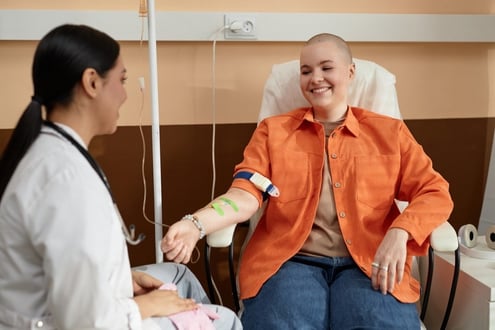Treating Cancer with Targeted Therapy
Using to treat cancer
Targeted therapies are designed to attack or kill cancer cells, while sparing normal cells as much as possible. These therapies are often designed to attach to abnormal proteins, receptors or genes that are found in high quantities in cancer cells or the surrounding tissue.
How are targeted therapies selected?
Some, but not all targeted therapies work best against cancer cells with certain markers or mutations. Two important types of tests can help guide selection of these targeted therapies.
- testing involves looking at tumor, blood or other other tissue samples for abnormal markers that might indicate the cancer is likely to respond to a particular . You can learn more about testing for selecting targeted therapies in our Biomarkers sections.
- Genetic testing for inherited mutations can also help guide treatment with targeted therapies. PARP inhibitors, for example, are a type of that are most effective for treating cancer in people with a or mutation.
Each drug has different uses. Indications vary by:
- type and of cancer.
- presence of a mutation or .
- number of, and response to prior treatments.
Types of targeted therapies
There is a growing list of FDA-approved targeted therapies for cancer treatment. Many of these drugs are approved across multiple types of cancer as long as the cancer contains the right target or . Drugs that are approved across cancer types are sometimes called pan-tumor or tumor-agnostic therapies.
PARP inhibitors work by blocking a protein used to repair damaged . They were first developed to treat cancers in people with an inherited or mutation. Since then, research and additional approvals have expanded use of PARP inhibitors to more people and situations. Examples of PARP inhibitors include:
- Akeega ( and acetate)
- Lynparza ()
- ()
- ()
- ()
Kinases are enzymes (chemicals in the body that allow cells to function and grow). Kinase inhibitors are drugs that are designed to find and block enzymes from functioning. Examples of kinase inhibitors include:
- Ibrance (palbociclib)
- Kisqali (ribociclib)
- Truqap (capivasertib)
- Tukysa (tucatinib)
Some drugs are classified as both immunotherapies and targeted therapies because they use antibodies to target abnormal proteins or receptors that are found in high quantities in cancer cells or the surrounding tissue. Typically, monoclonal antibody drugs have a chemical name that ends with the letters "mab."
Examples of monoclonal antibodies include:
- Avastin (bevacizumab) kills cancer cells by blocking VEGF, a protein that tumors use to make new blood supply.
- Herceptin (trastuzumab), and similar anti-Her2 therapies, are monoclonal antibodies that work against the protein, which is found in large amounts on some types of cancer cells.
- Antibody-drug conjugates (ADCs) are drugs that combine two different types of molecules. An antibody that targets certain features of cancer cells is attached to chemotherapy (sometimes referred to as the "payload"). The antibody binds to the cancer cell and delivers the chemotherapy directly into the cell.
The tables below list some common targeted therapies used in cancer treatment and and the biomarkers that are used in their selection. Clincal trials are studying new agents for treating cancer.
|
Drug |
Cancer Type |
|
Use |
|
|
Lynparza () |
Breast cancer |
Early breast cancer at high risk for recurrence |
Given for one year as after completion of or chemotherapy and local treatment (surgery and, or radiation). |
or inherited mutation () |
|
Lynparza () |
Breast cancer |
For treatment of patients who have previously received chemotherapy, or hormone therapy for patients with hormone receptor disease. |
or inherited mutation and |
|
|
() |
Breast cancer |
For treatment of breast cancer. |
or mutation and |
|
|
Lynparza () |
Ovarian cancer |
3 or 4 |
maintenance therapy for people who had a complete or partial response to platinum chemotherapy. |
|
|
Lynparza () |
Ovarian cancer |
3 or 4 |
Combined with Avastin (bevacuzimab) for people who had a complete or partial response to platinum chemotherapy. |
|
|
Lynparza
|
Ovarian cancer |
3 or 4 |
Second-line or later for people who had a complete or partial response to platinum chemotherapy. |
No needed |
|
() |
Ovarian cancer |
3 or 4 |
For people who had a complete or partial response to platinum chemotherapy. |
No required |
|
Lynparza () |
Pancreatic cancer |
For people whose disease has not progressed on at least 16 weeks of platinum-based chemotherapy. |
in or |
|
|
Akeega ( and acetate) |
cancer |
castration-resistant cancer (mCRPC) |
In combination with prednisone for or later treatment of mCRPC. |
Inherited or tumor mutation in or based on FoundationOne tumor test |
|
Akeega ( and acetate) |
cancer |
castration-sensitive cancer (mCSPC) |
In combination with prednisone for or later treatment of mCSPC. |
Inherited or tumor mutation in based on FoundationOne tumor test |
|
Lynparza () |
cancer |
castration-resistant cancer (mCRPC) |
Combined with Zytiga and prednisone or prednisolone for or later treatment of mCRPC. |
|
|
Lynparza () |
cancer |
castration-resistant cancer (mCRPC) |
For treatment of mCRPC which has progressed following treatment with Xtandi () or Zytiga (). |
|
|
() |
cancer |
castration-resistant cancer (mCRPC) |
For treatment of mCRPC which has been treated with androgen receptor-directed therapy and a taxane-based chemotherapy. |
|
|
() |
cancer |
castration-resistant cancer (mCRPC) |
In combination with for mCRPC which has not yet been treated in the castration-resistant setting. |
Inherited or tumor mutation in one of the following genes: , , , ATR, CDK12, , FANCA, , MRE11A, , , or |
|
Drug |
Cancer Type |
|
Use |
|
Type of Agent |
|
Afinitor |
Breast cancer |
or advanced |
Combined with exemestane for postmenopausal women with advanced breast cancer which progressed with letrozole or anastrozole. |
, |
MTOR inhibitor |
|
Afinitor |
Pancreatic neuro-endocrine tumors (PNET) |
Progressive PNETs |
Used to treat PNETs that have progressed on other treatments. |
No needed |
MTOR inhibitor |
|
Avastin |
Ovarian, or primary peritoneal cancer |
2-4 |
Combined with Lynparza () for maintenance therapy for platinum-sensitive cancer. |
() |
VEGF inhibitor |
|
Avastin |
Ovarian, or primary peritoneal cancer |
3-4 |
Combined with chemotherapy, followed by Avastin as a single agent following initial surgical resection. |
No needed |
VEGF inhibitor |
|
Avastin |
Ovarian, or primary peritoneal cancer |
Recurrent |
Combined with chemotherapy for treating platinum-resistant, recurrent disease in people who received no more than 2 prior chemotherapy regimens. |
No needed |
VEGF inhibitor |
|
Avastin |
Ovarian, or primary peritoneal cancer |
Recurrent |
Combined with chemotherapy, followed by Avastin as a single agent, for platinum-sensitive recurrent disease. |
No needed |
VEGF inhibitor |
|
Avastin |
Colorectal cancer |
Combined with intravenous 5-fluorouracil-based chemotherapy for first-, or second-line treatment. |
No needed |
VEGF inhibitor |
|
|
Avastin |
Colorectal cancer |
Combined with chemotherapy for second-line treatment in patients who have progressed on a Avastin-containing regimen. |
No needed |
VEGF inhibitor |
|
|
Bizengri |
Pancreatic cancer |
For treating pancreatic cancer which got worse or came back on, or after prior treatment. |
NRG1 gene fusion |
Bi-specific (contains two targets) antibody targeting and HER3 receptors |
|
|
Braftovi |
Colorectal cancer |
Combined with cetuximab, for the treatment of adult patients with colorectal cancer. |
BRAF V600E tumor mutation |
BRAF inhibitor |
|
|
Braftovi |
Melanoma |
Combined with Mektovi (binimetinib), for the treatment of patients with unresectable or melanoma. |
BRAF V600E or V600K tumor mutation |
BRAF inhibitor |
|
|
Cotellic |
Melanoma |
Combined with Zelboraf (vemurafenib) for the treatment of patients with unresectable or melanoma. |
BRAF V600E or V600K tumor mutation |
BRAF inhibitor |
|
|
Cyramza |
Colorectal cancer |
Combined with FOLFIRI chemotherapy, for treatment after disease progression on, or after prior therapy with bevacizumab, oxaliplatin, and a fluoropyrimidine. |
No required |
VEGF inhibitor |
|
|
Datroway (datopotamab deruxtecan-dlnk) |
Breast cancer |
Treatment for cancers that have progressed after hormone therapy and chemotherapy. |
Hormone receptor position (), |
Antibody-drug conjugate (chemotherapy attached to antibody targeting TROP-2) |
|
|
ELAHERE (mirvetuximab soravtansine-gynx) |
Ovarian cancer |
3-4 |
Used as second-line or later treatment of platinum-resistant or platinum-sensitive recurrent ovarian cancer. |
Positive for FRα (folate receptor alpha) |
Antibody-drug conjugate (chemotherapy attached to antibody targeting FR-α receptor) |
|
Enhertu (fam-trastuzumab-deruxtecan-nxki) |
Breast cancer |
Treatment for people who have received a prior anti-HER2-based regimen either:
|
overexpression () |
Antibody-drug conjugate |
|
|
Enhertu (fam-trastuzumab-deruxtecan-nxki) |
Breast cancer |
As treatment for people who have tumors that are HER2-low, received chemotherapy in the setting and whose cancer no longer responds to hormonal therapy. |
and HER2-low |
Antibody-drug conjugate |
|
|
Enhertu (fam-trastuzumab-deruxtecan-nxki) |
Breast cancer |
As treatment for people with , HER2-low or ultralow that came back or got worse after one or more hormone therapies in the setting. |
and HER2-low or HER2-ultra low |
Antibody-drug conjugate |
|
|
Enhertu (fam-trastuzumab-deruxtecan-nxki) |
(pan tumor) |
or unresectable |
For adult patients with unresectable or , solid tumors (including colorectal cancer) who have received prior systemic treatment and have no alternative treatment options. |
overexpression () |
Antibody-drug conjugate |
|
Erbitux |
Colorectal cancer |
Combined with FOLFIRI for treatment, or combined with irinotecan for cancers that no longer respond to irinotecan-based chemotherapy or as a single agent in patients who have progressed after oxaliplatin- and irinotecan-based chemotherapy. |
EGFR positive and KRAS mutation negative |
EGFR inhibitor |
|
|
Fruzaqla |
Colorectal cancer |
Used as a single agent when cancer has progressed after treatment with chemotherapy and . |
No required |
VEGF inhibitor |
|
|
Herceptin |
Breast cancer |
Early |
The treatment of breast cancer. |
overexpression () |
Antibody targeting receptors |
|
Herceptin (trastuzumab) and Tukysa (tucatinib) combination |
Colorectal cancer |
or unresectable |
For people who progressed after chemotherapy. |
overexpression () |
Antibody targeting receptors and a kinase inhibitor that targets receptors |
|
Ibrance |
Breast cancer |
Combined with an aromatase inhibitor as treatment of advanced cancer as initial hormone therapy in postmenopausal women or in men. |
and |
known as a kinase inhibitor that blocks the CDK4/6 pathway |
|
|
Ibrance |
Breast cancer |
Combined with Faslodex (fulvestrant) as treatment in postmenopausal women or in men whose disease progressed following endocrine therapy. |
and |
known as a kinase inhibitor that blocks the CDK4/6 pathway |
|
|
Inluriyo |
Breast cancer |
Used alone to treat men or postmenopausal women with , breast cancer, which progressed after at least one line of hormone therapy therapy. |
, with an ESR1 mutation |
Type of targeted hormonal therapy known as SERD (selective receptor degrader or downregulator) |
|
|
Kadcyla |
Breast cancer |
Early |
therapy for people with early breast cancer who still have disease after taxane and treatment with Herceptin |
overexpression () |
Antibody targeting receptors |
|
Kadcyla |
Breast cancer |
For treatment in people whose cancer got worse after receiving Herceptin and chemotherapy in the following settings:
|
overexpression () |
Antibody targeting receptors |
|
|
Kisqali |
Breast cancer |
Combined with an aromatase inhibitor for the treatment of pre/perimenopausal or postmenopausal women as initial hormone based therapy. |
and |
known as a kinase inhibitor that blocks the CDK4/6 pathway |
|
|
Kisqali |
Breast cancer |
Combined with Faslodex (fulvestrant) for the treatment of postmenopausal women, as initial hormone based therapy. |
and |
known as a kinase inhibitor that blocks the CDK4/6 pathway |
|
|
Krazati (adagrasib) |
Colorectal cancer |
In combination with cetuximab for locally advanced or colorectal cancer (CRC) that has progressed after treatment with chemotherapy. |
KRASG12C mutation |
against the KRASG12C protein |
|
|
Lenvima (lenvatinib) |
Endometrial cancer |
Advanced disease |
Combined with pembrolizumab, for the treatment of patients whose cancer has progressed after treatment and who are not candidates for surgery or radiation. |
Tumors that are not MSI-H or (or ) - they may be referred to as MSI-Low, MSS, pMMR or MMR-P) |
known as a tyrosine kinase inhibitor |
|
Mekinist (trametinib) |
Melanoma |
Unresectable or |
As a single agent and in combination with dabrafenib for the treatment of unresectable or melanoma. |
BRAF V600E or V600K tumor mutation |
known as a MEK inhibitor |
|
Mekinist (trametinib) |
Melanoma |
Lymph node positive |
Combined with Taflinar (dabrafenib) as treatment of people with melanoma and involvement of lymph node(s), following complete resection. |
BRAF V600E or V600K tumor mutation |
known as a MEK inhibitor |
|
Mektovi (binimetinib) |
Melanoma |
Unresectable or |
Combined with Braftovi (encorafenib), for the treatment of people with unresectable or melanoma. |
BRAF V600E or V600K tumor mutation |
known as a MEK inhibitor |
|
Orserdu |
Breast cancer |
Used alone to treat men or postmenopausal women with , breast cancer, which progressed after at least one line of hormone therapy therapy. |
, with an ESR1 mutation |
Type of targeted hormonal therapy known as SERD (selective receptor degrader or downregulator) |
|
|
Perjeta (pertuzumab) |
Breast cancer |
Locally advanced, inflammatory or early |
Combined with Herceptin (trastuzumab) and docetaxel as treatment before surgery (). |
overexpression () |
Antibody targeting receptors |
|
Phesgo (pertuzumab, trastuzumab combined injection) |
Breast cancer |
Early |
|
overexpression () |
Antibody targeting receptors |
|
Piqray |
Breast cancer |
Combined with Faslodex (fulvestrant) as treatment in men or post-menopausal women who progressed on or after treatment with hormone therapy. |
, and positive for a PIK3CA tumor mutation |
known as a kinase inhibitor that blocks the PIK3 pathway |
|
|
Pluvicto (lutetium Lu 177 vipivotide tetraxetan) |
cancer |
castration-resistant cancer (mCRPC) |
For treatment of mCRPC which has stopped responding or got worse after treatment with hormonal therapy using an androgen receptor inhibitor and taxane-based chemotherapy. |
Imaging with a that looks for cancers with the marker PSMA |
Targeted radiation therapy (radioligand therapy) |
|
Retevmo (selpercatinib) |
(pan tumor) |
or unresectable |
Second-line or later treatment for solid tumors for which there are no other treatment options. |
RET fusion |
Kinase inhibitor |
|
Stivarga (regorafenib) |
Colorectal cancer |
|
For treatment of colorectal cancer that has progressed after treatment and for which there are no other treatment options. |
No required |
known as a multi-kinase inhibitor |
|
Tafinlar |
Melanoma |
Unresectable or |
Combined with Mekinist (trametinib) for the treatment of people with unresectable or melanoma. |
BRAF V600E or V600K tumor mutation |
known as a BRAF inhibitor |
|
Tafinlar |
Melanoma |
Lymph node positive |
Combined with Mekinist (trametinib) as treatment of people with melanoma and involvement of lymph node(s), following complete resection. |
BRAF V600E or V600K tumor mutation |
known as a BRAF inhibitor |
|
Trodelvy (sacituzumab govitecan-hziy) |
Breast cancer |
For breast cancer that progressed, recurred or did not respond to at least two previous lines of treatment. |
Triple-negative (, ) |
Antibody-drug conjugate (chemotherapy attached to antibody found in ) |
|
|
Truqap |
Breast cancer |
Combined with fulvestrant as treatment for , advanced or breast cancer which recurred or got worse after standard hormone therapy. |
, PIK3 or AKT1 mutation in the tumor |
known as a kinase inhibitor that blocks the AKT pathway |
|
|
Tukysa (tucatinib) |
Breast cancer |
or unresectable |
In combination with Herceptin (trastuzumab) to treat cancer which has progressed after at least one prior treatment with an anti-HER2 treatment in the setting. |
overexpression () |
known as a kinase inhibitor that targets receptors |
|
Vectibix |
Colorectal cancer |
Combined with FOLFOX for treatment. |
Negative for KRAS and NRAS mutations |
that targets a receptor known as EGFR |
|
|
Vectibix |
Colorectal cancer |
As a single therapy following disease progression after prior treatment with fluoropyrimidine, oxaliplatin, and irinotecan-containing chemotherapy. |
Negative for KRAS and NRAS mutations |
that targets a receptor known as EGFR |
|
|
Verzenio (abemaciclib) |
Breast cancer |
Used alone to treat breast cancer that has progressed after treatment with hormone therapy and chemotherapy in the setting. |
and |
known as a kinase inhibitor that blocks the CDK4/6 pathway |
|
|
Verzenio (abemaciclib) |
Breast cancer |
Combined with Faslodex (fulvestrant) as treatment in women whose disease progressed following endocrine therapy. |
and |
known as a kinase inhibitor that blocks the CDK4/6 pathway |
|
|
Vitrakvi (larotrectinib) |
(pan tumor) |
or unresectable |
For treatment in solid tumors for which there are no other treatment options. |
NTRK fusion |
Kinase inhibitor |
|
Xofigo (Radium 223 dichloride) |
cancer |
castration-resistant cancer (mCRPC) |
For treatment of mCRPC that has spread to the bones but has not to other organs. |
No needed |
Targeted radiation therapy (radioligand therapy) |
|
Zelboraf (vemurafenib) |
Melanoma |
Unresectable or |
Combined with Tecentriq (atezolizumab) and Cotellic (cobimetinib) in people with melanoma that has the BRAF gene mutation, when the cancer can’t be removed by surgery or has spread to other parts of the body. |
BRAF V600E or V600K tumor mutation |
known as a BRAF inhibitor |
Side effects of targeted therapy
Like any medication, targeted therapies may cause side effects. Although some effects are more common with certain medications, each person's experience may be different. Side effects may vary depending on your general health, the type of agent and dose you are on, other medications you take, the site of your cancer and other factors.
Not all people experience side effects, but those who do may have options for minimizing or eliminating some of them. It's important to talk with your doctor about possible treatment for side effects and how they can be managed. Consider participating in a clinical trial that is looking at new ways to manage treatment side effects.
Some of these effects may improve with medication or other medical interventions. It's important that you report any symptoms or changes in your health to your doctor. You may also report any suspected side effects directly to the online or by calling 1-800-FDA-1088.
- Allergic reaction
- Anemia, bleeding and low white blood cell counts
- Birth defects
- Fatigue
- Heart damage
- Joint or muscle pain
- Mouth and tongue sores
- Nausea, vomiting and appetite changes
- Rashes
- Risk for additional cancers
Any therapy can cause an allergic reaction in someone who is sensitive to the medication. Allergic reactions may range from mild to severe. Rarely these reactions can be fatal. Your oncologist may prescribe medication to decrease your risk for severe allergic reactions caused by targeted therapies.
Anemia, bleeding and low white blood cell counts
Some targeted therapies damage bone marrow, where blood cells are made. This can result in too few red blood cells (anemia), too few platelets (thrombocytopenia) and a low white blood cell count (neutropenia).These bone marrow effects can lead to symptoms like fatigue, rapid heart rate, bleeding and increased risk for infection. Most of the time, these changes are mild. Your oncologist may test your blood, to make sure that your blood counts do not drop too low, which could delay treatment.
Many targeted therapies can cause birth defects. People are cautioned not to become pregnant while on targeted therapies. It's important to speak with your doctor about your plans for pregnancy before starting treatment.
Fatigue may be caused by cancer or treatments, including targeted therapies. You should report fatigue to you doctors so they can check and treat you for underlying causes, including depression, sleep disturbances and medication side effects. You may be able to improve your energy level with these suggestions:
- making sure that your diet is balanced and provides you with adequate nutrition. Ask your doctor for a referral to a nutritionist if you need help figuring out your nutritional needs.
- making sure that you get adequate sleep.
- trying to stay physically active, which can help improve your energy level.
Certain immunotherapies—especially anti-Her2 therapies—can cause heart damage. Your oncologist may run tests to make sure that your heart function is normal before, during and after treatment. Some drugs may help protect the heart from damage caused by these agents. Heart damage caused by treatment can also be minimized by lowering the dose, changing how it is given or switching to different drug.
Certain targeted therapies may cause joint or muscle pain. Exercise, yoga, and acupuncture may help relieve joint pain. Ask your doctor about whether you can take nonsteroidal anti-inflammatories or other medication to improve joint pain caused by these therapies.
Some targeted therapies can cause painful sores of the mouth and lips (called stomatitis), which can make eating painful. Certain medications and mouthwashes can help to repair mouth cells, coat the sores or block the pain caused by the sores. Rinsing your mouth with salt or baking soda can also improve mouth sores.
Nausea, vomiting and appetite changes
Several different medications help to reduce nausea during treatment. This can improve appetite, reduce weight loss and support a balanced diet—referral to a nutritionist can help assure that you maintain a balanced diet during treatment. Certain foods may be more or less likely to trigger nausea, vomiting or upset stomach.
Some targeted therapies, especially monoclonal antibody drugs, can cause rashes. Rashes may range from mild to severe, depending on the agent.
Increased risk for certain secondary cancers may occur after treatment. The risk is usually small. Cancers that may be increased include skin cancers and acute myeloid leukemia.
|
Type of Agent |
Name of Agents |
Common Side Effects |
Serious Side Effects |
|
AKT inhibitor |
Truqap |
|
|
|
Anti-Her2 kinase inhibitor |
Tukysa (tucatinib) |
|
|
|
Anti-HER2 antibody |
|
|
|
|
BRAF and MEK inhibitors |
|
|
|
|
CDK 4/6 inhibitors |
|
|
|
|
Anti-EGFR antibody |
Erbitux (cetuximab) |
|
|
|
Anti-EGFR antibody |
Vectibix (panitumumab) |
Used alone:
When combined with chemotherapy:
|
|
|
Antibody-drug conjugate |
Datroway (datopotamab deruxtecan-dlnk) |
|
|
|
Antibody-drug conjugate |
Trodelvy (sacituzumab govitecan-hziy) |
|
|
|
Anti-VEGF or VEGF receptor antibody |
|
|
|
|
MTOR inhibitor |
Afinitor (everolimus) |
|
|
|
Multi-target kinase inhibitor |
|
|
|
|
PARP inhibitors |
|
|
|
|
PIK3 inhibitor |
Piqray (alpelisib) |
|
|
Questions for your doctor
Below are some questions to ask your doctor about as part of your treatment plan.
- Am I a candidate for ?
- Are there any or genetic tests that can predict if will work for me?
- What is the name of the that I am taking?
- What is the goal of this treatment?
- How long will I be on this ?
- What are some of the side effects I may experience while I'm on ? When am I most likely to experience them?
- If I experience side effects that I cannot tolerate, can I stop the medication, reduce the dose or switch to another medication?
- What are the serious side effects I should look for? Who should I contact if I experience them?
- Are there any medications or steps that I can take to avoid or lessen side effects?
- How will you monitor me while I'm on this medication?
- What are my options if my cancer comes back while on, or after taking this ?
- What are the long-term effects that I should look for? Who will monitor me for these effects?
A Study of Targeted Therapies for Patients With Recurrent Endometrial Cancer
Clinicaltrials.gov identifier: NCT04486352
Clinicaltrials.gov identifier: NCT06167317
Clinicaltrials.gov identifier: NCT04008797
This review summarizes the results of the TALAPRO2 study. It...
Treatment before surgery with a combination of targeted therapy and...
Study : FDA approves new targeted therapy for advanced pancreatic cancer
A new treatment called Bizengri has been approved by the...










